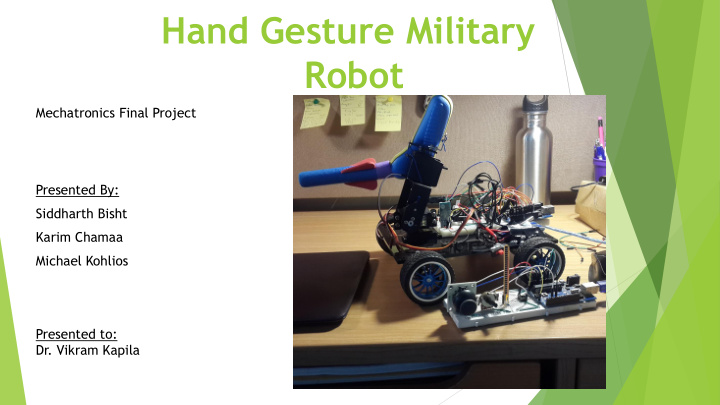



Hand Gesture Military Robot Mechatronics Final Project Presented By: Siddharth Bisht Karim Chamaa Michael Kohlios Presented to: Dr. Vikram Kapila
Outline Introduction Project Statement Solution Proposed Management of Work Building the Prototype Circuit Design Coding Guidelines for Safe Operation Cost Analysis Advantages vs Drawbacks Future Improvements Conclusions References
Introduction The use of robotics technology in military led to a new field called Military Robotics Military robots come in different shapes and sizes as per the task they are created for Main function of robots nowadays is to assist and support the armed forces.
Problem Statement USA and many other countries are losing many military personnel during war on terror. A way of fighting a war, while preserving the lives of as many armed forces members is paramount and is the problem we are looking to solve.
Solution Proposed Building a hand gesture military robot: Goals: Ensure safety of field officers Fast deploying in a war battle Overcome harsh terrain Provide feedback Control arm by hand gesture Aim at a target Fire a projectile at it
Management of Work: Mind Mapping
Management of Work: Program Evaluation and Review Technique (PERT)
Building the Prototype: Assembling Robot Chassis and Wiring motors Selection Criteria: Overcome harsh terrain Good manoeuvrability Robust Chassis selection: Geared DC motors 4 wheel System Skidding steering
Building the Prototype: Aiming at the Target Selection Criteria: Cover a large area Easily controlled Fast response Cheap Chassis selection: 2 DOF Servo System Standard Servos Tilt Sensor
Building the Prototype: Shooting Mechanism Consisting of: Wire Gun Standard Servo Flex Sensor
Building the Prototype: Control Base Platform Hand Gesture Control of Servos: Tilt Sensor Aiming Flex Sensor Shooting Mobile Robot Control: Joystick Direction Potent Speed
Circuit Design: Control Base
Circuit Design: Mobile Robot
Coding
Coding: Control Base Code
Coding: Robot Code
Guidelines For safe Operation Two main features: 1)Monitoring battery voltage 2)Monitoring battery and surrounding temperature
Cost Analysis Materials Quantity Usage Unit of Measure Unit Cost Usage Cost Robot Chassis 1 Each 50$ 50$ Flex Sensor 1 Each 10$ 10$ Parallax Tilt 1 Each 10$ 10$ Arduino R3 2 Each 5$ 10$ Joystick 1 Each 2$ 2$ 10K Pot 1 Each 1$ 1$ Resistor Package 6/600 Each 2.5$ 0.025$ Breadboards 2 Each 5$ 10$ Jumper Wires 2 Each 7$ 14$ 2DOF Servo 1 Each 30$ 30$ Lippo Batteries 2 Each 10$ 20$ HC_05 Bluetooth 1 Each 15$ 15$ Voltage Regulator 2 Each 1$ 2$ L293D H-Bridge 1 Each 0.5$ 0.5$ Thermistor 1 Each 3$ 3$ Parallax Servo 1 Each 25$ 25$ Prototype Total Cost= 202.525$
Advantages and Drawbacks LabVIEW should always remain Military work without risking running on a pc. human lives Slow response due to number of Relatively Inexpensive data sent and received. Easy to use and deploy Robotic systems tend to make a lot Robot can be more mobile than of noise, which can reveal their human units position to enemies. Use of Robot is limited by range of communication
Future Improvements Include real time vision system Communication using satellite connection Hand gestures mimicked using a combination of gyroscopes and accelerometers Going even further than the military field, similar robotic systems can be used in many different facets of life!
Conclusions Implementation of this robot would reduce the casualties of war. The system consisted of a remote controlled four wheeled robot that utilizes hand gestured to be controlled. Future work may include improvements in the hand gesture, communication and vision.
References [1] Banzi , M. (2010). In “Getting Started with Arduino”. Published by Make: Books and imprint of Maker Media, Inc.” [2] Blum, J. (2013). In Exploring Arduino: Tools and Techniques for Engineering Wizardry”. John Wiley and Sons, Inc. (Wiley, 978 -1-118-54946-0). [3] Warren. J. & Adams, J. & Molle, H. (n.d. ). In “Arduino Robotics”.
Thank You Questions ?
Recommend
More recommend